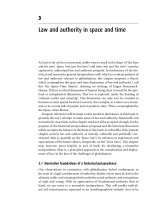Lecture 23 geologic history and time
Bạn đang xem bản rút gọn của tài liệu. Xem và tải ngay bản đầy đủ của tài liệu tại đây (11.41 MB, 77 trang )
Chapter 12: History Before History (Part 1)
Class Announcements:
Midterm exam results should
be ready on Wednesday. Updated
grade record will be posted then.
Exam key posted in glass case
outside lecture hall.
Field trips this week. Be sure to read
instructions on website and bring
a pencil and eraser!
Extra Credit exercise on “The Core”
is due Friday.
An updated course schedule on
website after class today.
TODAY’s LECTURE:
Chapter 12:
Intro. to Historical Geology
1)
2)
3)
4)
5)
Geologic Time Scale
Relative age dating principles
Unconformities
Correlation of rock units
Absolute dating using
radioactivity
6) Development of the Geologic
Time Scale
Where did the
geologic time
scale come from?
Built up
over time by
correlation and
relative dating
of rocks
from around
the world!
Relative Dating: Key principles
Telling time in Geology:
❖ Earth’s history is recorded in rocks
of the crust…
❖ Geology seeks to unravel this history!
❖Two basic time keeping methods:
Relative dating - Place events in their proper
order.
Absolute dating - Determine, in years before the
present, when event actually occurred.
Relative Dating: Main Principles
Law of superposition
Principle of lateral
continuity
Principle of original
horizontality
Principle of cross-cutting
relationships
Rule of inclusions
Relative Dating: Main Principles
Law of superposition: In a sedimentary sequence
that
has
notisbeen
oldest
rock
A bed
of rock
older overturned,
than that above,the
younger
than
that units
below
are always at the bottom.
Original lateral continuity
Original horizontality
Cross-cutting relationships
Rule of inclusions
Fig. 12.04c
W. W. Norton
Relative Dating:
Dating: Main
Main Principles
Principles
Relative
Youngest
Oldest
Principle of Superposition
Law of superposition
Principles of Relative Dating
Principle of original lateral continuity: Most
sedimentary rock units were originally deposited
over a large area, but later became isolated by
erosion or faulting
Principle of original
horizontality:
Principle of
cross-cutting
relationships
Rule of Inclusions
Fig. 12.04fg
W. W. Norton
Fig. 12.11c
W. W. Norton
Note that geologic units can also
disappear between localities
because of a lateral transition
in environments if deposition.
Law of superposition
Principle of original
lateral continuity
Principles of
relative dating
Principle of original horizontality: Sedimentary layers
are originally deposited lying flat (i.e. ~parallel to
the Earth’s surface.
Principle of
cross-cutting
relationships
Rule of Inclusions
Sedimentary units deposited ~ flat
and parallel to the earth’s surface.
Original horizontality
So, what
happened
here?
Principle of Original Horizontality
What happened here?
Principle of Original Horizontality
Principles of Relative Dating
Law of superposition
Lateral of original
continuity
Principle of original
horizontality
Principle of cross-cutting relationships:
If one rock unit cuts across another, it is younger!
Rule of Inclusions
If something cuts something else,
it has to be younger than what it cuts.
Fig. 12.04h
W. W. Norton
Principle of cross-cutting relationships.
Which vein is youngest, ‘A’ or ‘B’?
‘B’
‘A’
Principle of Cross-cutting relationships
Principles of Relative Dating
Law of superposition
Lateral of original continuity
Principle of original horizontality
Principle of cross-cutting relationships
Rule of Inclusions: If a unit contains a clast,
or inclusion of another rock unit, the clast
or inclusion is older.
If a rock unit contains a piece of
another rock unit, the piece is older.
Fig. 12.04i
W. W. Norton
Rule of Inclusions
Principles of Relative Dating
Rule of Inclusions:
Fragments of one rock included in another.
Example
from
Papago
Park
fieldtrip…
Unconformities are buried
surfaces of erosion or
non-deposition…
Modern erosion surface
Fig. 12.04e
Stephen Marshak
Unconformities dominate
the geologic record…
Most of the rock
record consists
of unconformities,
or time gaps
in the record.
That is… most of
geologic history
was unrecorded,
or was recorded
and later lost
by erosion.









